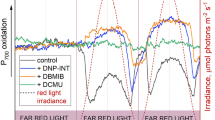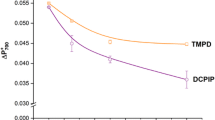Abstract
Dibromothymoquinone (DBMIB) has been used as a specific inhibitor of plastoquinol oxidation at the Q0 binding site of the cytochrome b6f complex for 40 years. It is thought to suppress electron transfer between photosystem (PS) II and I, as well as cyclic electron transfer around PSI. However, DBMIB has also been reported to act as a quencher of chlorophyll excited states. In this study, we have re-evaluated the effects of DBMIB on chlorophyll excited states and PSII photochemistry. The results show that DBMIB significantly quenches the chlorophyll excited states of PSII antenna even at low concentration (from 0.1 μM), lowering the effective excitation rate of the actinic light. It also acts as a potent PSII electron acceptor retarding the reduction of the plastoquinone pool with almost maximal potency at 2 μM. Altogether, these results suggest that experiments using DBMIB can easily be misinterpreted and stress on the importance of taking into account all these side effects that occur in the same range of DBMIB concentration used for inhibition of plastoquinol oxidation (1 μM).
Graphical abstract









Similar content being viewed by others
Abbreviations
- Chl:
-
Chlorophyll
- Cyt:
-
Cytochrome
- DBMIB:
-
Dibromothymoquinone
- DCMU:
-
3-(3,4-Dichlorophenyl)-1,1-dimethylurea
- PSII:
-
Photosystem II
- Pheo:
-
Pheophytin
- PQ:
-
Plastoquinone
- QA and QB :
-
Primary and secondary electrons acceptors of PSII
- TL:
-
Thermoluminescence
References
Allakhverdiev SI (2011) Recent progress in the studies of structure and function of photosystem II. J Photochem Photobiol B 104:1–8
Belatik A, Essemine J, Hotchandani S, Carpentier R (2012) Afterglow thermoluminescence band measured in isolated chloroplasts. Photochem Photobiol 88:67–75
Ben-Amotz A, Avron M (1973) NADP specific dihydroxyacetone reductase from Dunaliella parva. FEBS Lett 29:153–155
Boisvert S, Joly D, Carpentier R (2006) Quantitative analysis of the experimental O-J-I-P chlorophyll fluorescence induction kinetics. Apparent activation energy and origin of each kinetic step. FEBS J 273:4770–4777
Bukhov NG, Sridharana G, Egorovaa EA, Carpentier R (2003) Interaction of exogenous quinones with membranes of higher plant chloroplasts: modulation of quinone capacities as photochemical and non-photochemical quenchers of energy in photosystem II during light–dark transitions. Biochim Biophys Acta 1604:115–123
Chain RK, Malkin R (1979) On the interaction of 2,5-dibromo-3-methyl-6-isopropylbenzoquinone (DBMIB) with bound electron carriers in spinach chloroplasts. Arch Biochem Biophys 197:52–56
Dekker JP, van Grondelle R (2000) Primary charge separation in photosystem II. Photosynth Res 63:195–208
Diner BA, Babcock GT (1996) Structure, dynamics, and energy conversion efficiency in photosystem II. In: Ort DR, Yocum CF (eds) Oxygenic photosynthesis: the light reactions. Kluwer Academic Publishers, Dordrecht, pp 213–247
Draber W, Trebst A, Harth E (1970) On a new inhibitor of photosynthetic electron-transport in isolated chloroplasts. Z Naturforsch B25:1157–1159
Ducruet JM (2003) Chlorophyll thermoluminescence of leaf discs: simple instruments and progress in signal in interpretation open the way to new ecophysiological indicators. J Exp Bot 54:2419–2430
Ducruet JM, Roman M, Ortega JM, Janda T (2005a) Role of the oxidized secondary acceptor QB of photosystem II in the delayed afterglow chlorophyll luminescence. Photosynth Res 84:161–166
Ducruet JM, Roman M, Havaux M, Janda T, Gallais A (2005b) Cyclic electron flow around PSI monitored by afterglow luminescence in leaves of maize inbred lines (Zea mayz L.): correlation with chilling tolerance. Planta 221:567–579
Gauthier A, Govindachary S, Harnois J, Carpentier R (2006) Interaction of N, N, N′, N′-tetramethyl-p-phenylenediamine with photosystem II as revealed by thermoluminescence: reduction of the higher oxidation states of the Mn cluster and displacement of plastoquinone from the QB niche. Biochim Biophys Acta 1757:1547–1556
Gould JM, Izawa S (1973) Photosystem II electron transport and phosphorylation with dibromothymoquinone as the electron acceptor. Eur J Biochem 37:185–192
Guskov A, Kern J, Gabdulkhakov A, Broser M, Zouni A, Saenger W (2009) Cyanobacterial photosystem II at 2.9-Å resolution and the role of quinones, lipids, channels and chloride. Nat Struct Mol Biol 16:334–342
Havaux M, Rumeau D, Ducruet JM (2005) Probing the FQR and NDH activities in cyclic electron transport around photosystem I by the afterglow luminescence. Biochim Biophys Acta 1709:203–213
Joly D, Carpentier R (2011) Rapid isolation of intact chloroplasts from spinach leaves. In: Carpentier R (ed) Photosynthesis research protocols. Springer, New York, pp 321–325
Joly D, Bigras C, Harnois J, Govindachary S, Carpentier R (2005) Kinetic analyses of the OJIP chlorophyll fluorescence rise in thylakoid membranes. Photosynth Res 84:107–112
Kitajima M, Butler WL (1975) Quenching of chlorophyll fluorescence and primary photochemistry in chloroplasts by dibromothymoquinone. Biochim Biophys Acta 376:105–115
Krieger A, Bolte S, Dietz KJ, Ducruet JM (1998) Thermoluminescence studies on the facultative crassulacean-acid-metabolism plant Mesembryanthemum crystallinum L. Planta 205:587–594
Lazar D (1999) Chlorophyll a fluorescence induction. Biochim Biophys Acta 1412:1–28
Lazar D (2003) Chlorophyll a fluorescence rise induced by high light illumination of dark-adapted plant tissue studied by means of a model of photosystem II and considering photosystem II heterogeneity. J Theor Biol 220:469–503
Lazar D (2006) The polyphasic chlorophyll a fluorescence rise measured under high intensity of exciting light. Funct Plant Biol 33:9–30
Nellaepalli S, Mekala NR, Zsiros O, Mohanty P, Rajagopal S (2011) Moderate heat stress induces state transitions in Arabidopsis thaliana. Biochim Biophys Acta 1807:1177–1184
Pisciotta JM, Zou Y, Baskakov IV (2010) Light-dependent electrogenic activity of cyanobacteria. PLoS One 5. Article no e10821
Porra RJ, Thompson WA, Kriedemann PE (1989) Determination of accurate extinction coefficients and simultaneous equations for assaying chlorophyll a and b extracted with four different solvents: verification of the concentration of chlorophyll standards by atomic absorption spectroscopy. Biochim Biophys Acta 975:384–394
Rajagopal S, Egorova EA, Bukhov NG, Carpentier R (2003) Quenching of excited states of chlorophyll molecules in submembrane fractions of photosystem I by exogenous quinones. Biochim Biophys Acta 1606:147–152
Renger G, Kühn P (2007) Reaction pattern and mechanism of light induced oxidative water splitting in photosynthesis. Biochim Biophys Acta 1767:458–471
Roncel M, Ortega JM (2005) Afterglow thermoluminescence band as a possible early indicator of changes in the photosynthetic electron transport in leaves. Photosynth Res 84:167–172
Sane PV (2004) Thermoluminescence: a technique for probing photosystem II. In: Carpentier R (ed) Photosynthesis research protocols. Humana Press, Totova, New Jersey, USA, pp 229–248
Schansker G, Tóth SZ, Strasser RJ (2005) Methylviologen and dibromothymoquinone treatments of pea leaves reveal the role of photosystem I in the Chl a fluorescence rise OJIP. Biochim Biophys Acta 1706:250–261
Townsend JS, Kanazawa A, Kramer DM (1998) Measurements of S2Q −B recombination by delayed thermoluminescence reveal heterogeneity in photosystem II energetics. Phytochemistry 47:641–649
Trebst A (2007) Inhibitors in the functional dissection of the photosynthetic electron transport system. Photosynth Res 92:217–224
Vass I, Govindjee (1996) Thermoluminescence from the photosynthetic apparatus. Photosynth Res 48:117–126
Zhu XG, Govindjee Baker N, DeSturler E, Ort D, Long S (2005) Chlorophyll a fluorescence induction kinetics in leaves predicted from a model describing each discrete step of excitation energy and electron transfer associated with photosystem II. Planta 223:114–133
Author information
Authors and Affiliations
Corresponding author
Rights and permissions
About this article
Cite this article
Belatik, A., Joly, D., Hotchandani, S. et al. Re-evaluation of the side effects of cytochrome b6f inhibitor dibromothymoquinone on photosystem II excitation and electron transfer. Photosynth Res 117, 489–496 (2013). https://doi.org/10.1007/s11120-013-9798-1
Received:
Accepted:
Published:
Issue Date:
DOI: https://doi.org/10.1007/s11120-013-9798-1




